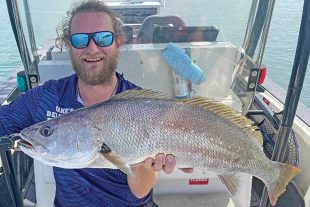March is normally an excellent month to chase fish and crustaceans around Brisbane.
Mud crabs were well and truly on the move towards the end of January, and there were also plenty of smaller prawns getting around, which meant things were looking good for the coming weeks.
Then the rain turned up and dumped 300mm overnight around the north Brisbane area.
The Pine and Caboolture rivers were hit very hard – it will take some time for them to clear enough for crabs, prawns and fish to move back in.
Flathead were around in good numbers too before the rain hit.
We were getting anywhere between 10-30 flatties in a session, with good fish over 60cm among them.
At the time of writing, I guess these fish are now somewhere closer to Moreton Island!
Hopefully they come back once the cleaner water starts to push back into the rivers.

It could take a good couple of weeks for any salty water to start pushing back in, so by the time the March issue hits the shelves it should be fishable, as long as we don’t receive any more rain between now and then.
I like fishing the dirty water – it concentrates the fish to an area that has some salt and they tend to bite better.
Trying different lures and colours can make a big difference in any situation, though it’s essential when fishing murky water.
My friend Benny was fishing for flatties before the rain flushed them out.
He was getting a few fish on the new white-coloured Pro Lure Clone Prawn, but the fish weren’t biting very well, with a few missed fish from it.
He swapped over to the chartreuse-coloured Pro Lure Clone Prawn and the fish instantly started belting it and better-quality fish started coming aboard.
The next afternoon, my son Luke and I jumped onto Benny’s boat, and we banged 30 flathead in 2 hours, nearly all on the chartreuse Pro Lure Clone Prawn.
There were also a stack of tailor feeding among the bait schools.

Quite a few of them were decent fish up around 50cm, so they were well worth targeting.
As the bait starts to push back in, I would expect flatties and tailor to move back in, however only time will tell.
Mangrove jack and estuary cod are species that don’t mind the dirty water.
After a good flush out, they will push back into systems very quickly and should be a good target this month.
I prefer to target jacks in discoloured water, especially down deep.
I find they are more aggressive, and the hook-up rate is excellent.
That doesn’t mean you will land the fish after it’s hooked though.
They have a well-deserved reputation as the ‘red dog’ of the estuaries and they rarely disappoint when hooked.

I’ve always done very well on dark coloured lures for mangrove jack in dirty water.
The deepest darkest red has always landed me plenty of jacks in these conditions.
White is another colour that works well.
Hard-bodied deep diving lures also excel in murky water.
They move a lot of water, make plenty of commotion under it and jacks struggle to resist eating them.
Trolling deep rocky areas is always a good option.
Make sure your leader is at least 40lb or above and be ready to tow them out of their homes.
Vibes that make plenty of noise in the water are also a good choice when the water is dirty.

Mud crabs will move back in quickly after the rain, though don’t be worried about crabbing very murky water.
If there’s a slight taste of salt in the water, there will be crabs on the move.
Often there are many empties getting about after the rain and some good crabs will also be among them, so check them to make sure they’re worth taking.
There are a few ways to tell if a crab is full.
The best way is to push under the carapace next to the triangle.

If this is hard, you have a good crab. The colour of the shell is often a giveaway too.
A brown or rusty colour generally means a good full crab.
If the shell is green and looks new, it could be empty.
A quick check underneath the carapace will let you know.
Worn claws are also a good sign that the crab has been feeding well and it will most likely be a good Esky filler.
That’s it from me this month.
Hopefully the rain gives us a break so the rivers can clear up enough to encourage fish and crabs to move back in.
Hope to see you on the water.
 Bush 'n Beach Fishing Magazine Location reports & tips for fishing, boating, camping, kayaking, 4WDing in Queensland and Northern NSW
Bush 'n Beach Fishing Magazine Location reports & tips for fishing, boating, camping, kayaking, 4WDing in Queensland and Northern NSW









